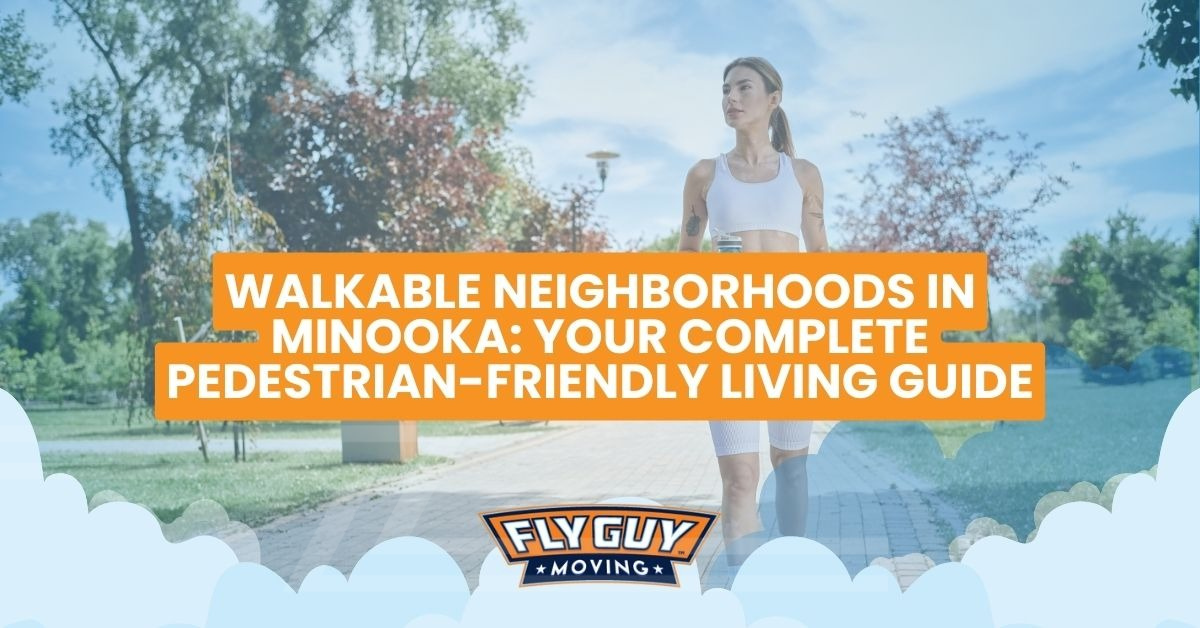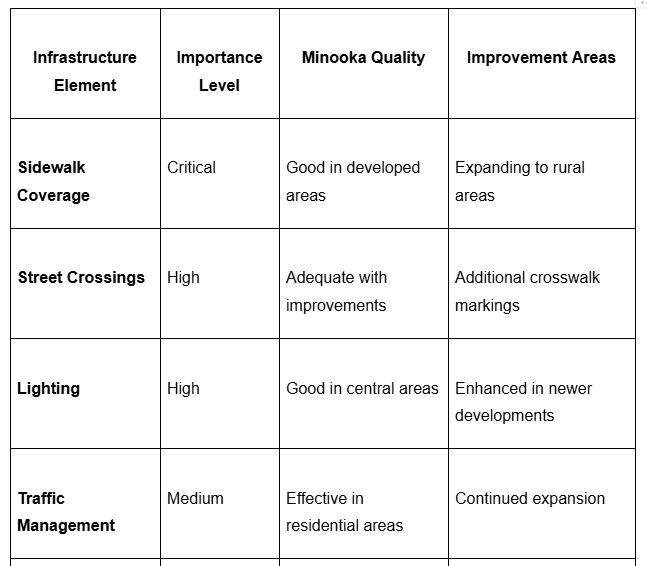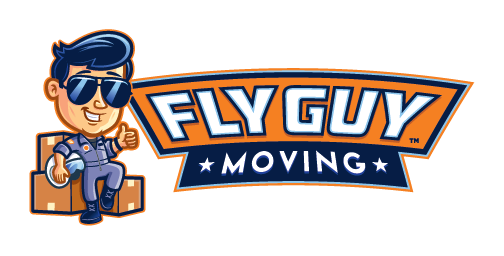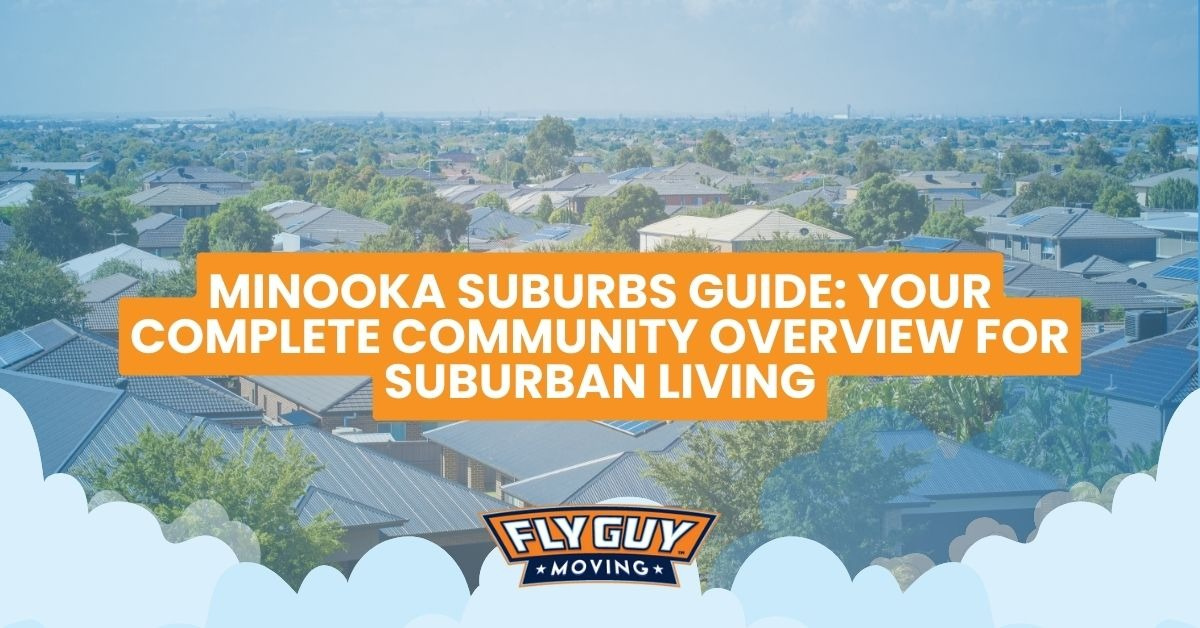Walkable Neighborhoods in Minooka: Your Pedestrian-Friendly Living Guide
Finding a neighborhood where you can accomplish daily tasks on foot can significantly enhance your quality of life and community connection, and we know that planning a move is both exciting and overwhelming when you're seeking communities that support active, pedestrian-friendly lifestyles. If you're researching walkable neighborhoods Minooka offers, you're exploring one of Illinois's most thoughtfully planned small cities, where strategic development and community design have created areas that support walking, biking, and reduced car dependence.
Car free neighborhoods Minooka may be limited by the city's suburban character, but several areas provide excellent walkability for daily needs, recreation, and community involvement. This comprehensive guide explores Minooka pedestrian neighborhoods that offer the best combination of walkable infrastructure, nearby amenities, and lifestyle benefits that make pedestrian-friendly living both practical and enjoyable.
As relocation specialists who help individuals and families move throughout Illinois, Fly Guy Moving understands that walkability considerations increasingly influence neighborhood selection decisions. The areas highlighted in this guide demonstrate how walk-friendly areas Minooka provides combine small-town charm with pedestrian accessibility, creating unique opportunities for residents seeking active, connected lifestyles.

Understanding Walkability in Minooka
Moving to walkable neighborhoods Minooka requires understanding how this small Illinois city accommodates pedestrian lifestyles while maintaining its suburban and rural character that attracts many residents.
Small City Advantages: Minooka's compact size and thoughtful development create opportunities for walkable living that larger cities often struggle to achieve, with shorter distances between residential areas and essential services.
Community Planning: Recent development emphasizes pedestrian-friendly design principles, including sidewalk connectivity, mixed-use development, and community amenities within walking distance of residential areas.
Infrastructure Investment: Municipal investment in sidewalks, crosswalks, and pedestrian safety features demonstrates commitment to supporting walkable lifestyles while maintaining community character and safety.
Mixed Development: Strategic integration of residential, commercial, and recreational uses creates opportunities for residents to accomplish multiple daily tasks within walkable distances.
Safety Considerations: Pedestrian friendly design includes appropriate lighting, clear sight lines, traffic calming measures, and emergency access that ensure safe walking conditions throughout different times of day.
Seasonal Adaptability: Illinois weather considerations in pedestrian infrastructure design, including snow removal, adequate lighting for shorter winter days, and shelter options during inclement weather.
Historic Downtown Minooka: Small-Town Walkability
Historic Downtown Minooka represents the heart of walkability Minooka offers, where compact development, local businesses, and community programming create authentic pedestrian-friendly environments.
Pedestrian Infrastructure
Sidewalk Networks: Comprehensive sidewalk systems connect residential areas to business districts, community facilities, and recreational venues, providing safe pedestrian routes throughout the downtown core.
Traffic Management: Speed limits, stop signs, and traffic calming measures designed to create pedestrian-friendly environments while maintaining vehicle access for residents and businesses.
Crossing Safety: Well-marked crosswalks, pedestrian signals where appropriate, and intersection design that prioritizes pedestrian safety and visibility throughout the downtown area.
Lighting Systems: Street lighting designed to provide safe pedestrian visibility during evening hours while maintaining the community character and historic atmosphere downtown residents value.
Walkable Amenities
Local Business District: Family-owned restaurants, shops, professional services, and community businesses within walking distance create opportunities to support local economy while meeting daily needs.
Community Services: Post office, library, city services, and essential community functions accessible via pedestrian routes, reducing transportation needs for routine civic and personal business.
Cultural Venues: Community theater, art galleries, and cultural programming within walking distance provide entertainment and cultural enrichment opportunities for pedestrian-oriented residents.
Dining and Social: Local restaurants, coffee shops, and gathering places that serve as social hubs while providing convenient dining and meeting options for walking residents.
Residential Integration
Mixed Housing: Apartments, condominiums, and single-family homes within walking distance of downtown amenities provide housing options for various budgets and lifestyle preferences.
Historic Character: Charming historic homes and tree-lined streets create attractive walking environments that enhance the pedestrian experience while preserving community character.
Community Events: Regular downtown events, festivals, and community programming that encourage pedestrian participation and create opportunities for neighbor connections and community involvement.
Convenience Services: Banking, medical services, and personal care businesses accessible on foot reduce the need for vehicle transportation for routine appointments and services.
Westwind Community: Planned Pedestrian Features
Westwind demonstrates how master-planned communities can incorporate Minooka neighborhoods with walkability through comprehensive design that supports pedestrian lifestyles within suburban development patterns.
Master-Planned Walkability
Trail Systems: Extensive network of walking and biking trails connecting residential areas, community amenities, recreational facilities, and natural areas throughout the community.
Internal Connectivity: Sidewalk systems and pedestrian pathways that connect different neighborhoods within Westwind, enabling residents to walk between areas without using main roads.
Community Center Access: Walking routes to community centers, recreational facilities, and programming venues that allow residents to participate in activities without driving within the community.
Natural Integration: Trail systems that incorporate natural areas, parks, and scenic routes, making pedestrian transportation both practical and enjoyable for daily recreation.
Amenity Accessibility
Recreation Walking: Swimming pools, tennis courts, fitness facilities, and recreational amenities accessible via pedestrian routes, supporting active lifestyles without vehicle dependence.
Community Programming: Events, classes, and social activities within walking distance of residential areas, encouraging community participation and neighbor connections through pedestrian access.
Maintenance Paths: Well-maintained walking surfaces, appropriate lighting, and regular upkeep that ensure safe, pleasant pedestrian experiences throughout different seasons and weather conditions.
Safety Features: Security lighting, emergency call boxes, and design features that provide security for pedestrians using trails and walkways during various times of day.
Suburban Walkability Balance
Neighborhood Scale: Community design that makes walking practical for residents while maintaining suburban character and accommodating vehicle access when necessary for longer trips.
Mixed Amenities: Variety of recreational, social, and practical amenities within walking distance provides options for different ages, interests, and daily needs.
Seasonal Considerations: Infrastructure designed for year-round use with appropriate snow removal, lighting, and weather protection that maintains walkability throughout Illinois seasons.
For detailed information about pedestrian amenities in this planned community, our comprehensive Living in Westwind: Complete Guide provides in-depth analysis of walking infrastructure, trail systems, and pedestrian-friendly features.
Community College Area: Educational District Walkability
The area surrounding educational facilities represents transit-friendly neighborhoods Minooka where institutional development creates pedestrian-oriented environments that serve both students and residential communities.
Educational District Features
Campus Connectivity: Sidewalk networks connecting residential areas to educational facilities, supporting students, faculty, and community members who prefer walking to campus activities and services.
Student Housing: Residential options within walking distance of educational facilities, creating pedestrian-friendly environments for students and young professionals associated with educational institutions.
Community Services: Businesses, services, and amenities that locate near educational facilities to serve campus populations while providing walkable conveniences for nearby residents.
Public Transportation: Bus stops, shuttle services, and transportation connections that complement walking infrastructure and extend pedestrian accessibility to broader regional opportunities.
Mixed-Use Development
Commercial Integration: Restaurants, shops, and services that cater to educational communities while serving broader residential populations, creating walkable business districts around institutional anchors.
Professional Services: Medical offices, banks, and professional services convenient to educational facilities that also serve neighborhood residents with pedestrian-accessible essential services.
Cultural Programming: Libraries, theaters, and cultural venues associated with educational institutions that provide pedestrian-accessible entertainment and enrichment for community residents.
Recreation Access: Sports facilities, fitness centers, and recreational amenities that serve both institutional and community populations through pedestrian-friendly access.
Community Integration
Neighborhood Connection: Residential areas that integrate with educational district development, creating walkable communities that benefit from institutional amenities and programming.
Intergenerational Interaction: Mixed-age communities where students, families, and older residents interact through shared pedestrian spaces and community amenities.
Economic Vitality: Business districts that benefit from educational institution foot traffic while serving broader community needs through walkable commercial development.
Northern Residential Areas: Neighborhood Walkability
Northern residential areas demonstrate neighborhoods near shops Minooka where suburban development incorporates pedestrian-friendly features that support neighborhood-scale walking for daily activities and recreation.
Neighborhood-Scale Walking
Local Connectivity: Sidewalk systems connecting residential streets to neighborhood schools, parks, and local businesses, enabling residents to walk for routine activities and recreation.
School Routes: Safe pedestrian routes to neighborhood schools that allow children to walk or bike with appropriate supervision, supporting active transportation and community connection.
Park Access: Walking routes to community parks, playgrounds, and recreational facilities that encourage active lifestyles while providing safe pedestrian access for families and individuals.
Neighborhood Services: Local businesses, medical offices, and services within walking distance of residential areas, reducing transportation needs for routine appointments and daily needs.
Suburban Pedestrian Features
Traffic Calming: Speed bumps, stop signs, and neighborhood traffic management that creates safe pedestrian environments while maintaining vehicle access for residents and services.
Sidewalk Coverage: Comprehensive sidewalk systems throughout residential areas that provide safe pedestrian routes and connect to broader community walking networks.
Lighting and Safety: Street lighting and pedestrian safety features appropriate for suburban neighborhoods while maintaining residential character and community atmosphere.
Crosswalk Safety: Marked crosswalks, pedestrian visibility features, and intersection design that prioritizes pedestrian safety in residential and school areas.
Family-Friendly Walking
Child Safety: Pedestrian infrastructure designed with children in mind, including appropriate sight lines, traffic management, and safe crossing opportunities for family walking activities.
Stroller Accessibility: Sidewalk design and maintenance that accommodates strollers, wheelchairs, and other mobility devices, ensuring pedestrian access for residents with diverse mobility needs.
Community Connections: Walking routes that connect residential areas to community events, programming, and social opportunities, encouraging neighbor interaction and community involvement.
Recreational Walking: Pleasant walking environments with trees, landscaping, and scenic routes that make pedestrian transportation enjoyable for recreation and daily activities.
For families interested in pedestrian-friendly communities, our best family neighborhoods in Minooka guide analyzes how walkable areas serve family priorities and children's pedestrian safety needs.
Walkability Infrastructure and Features
Understanding the infrastructure that supports pedestrian-friendly living helps residents evaluate neighborhoods and identify areas that best accommodate walking-oriented lifestyles.
Essential Pedestrian Infrastructure
Sidewalk Quality: Well-maintained sidewalks with appropriate width, surface quality, and accessibility features that accommodate pedestrians with diverse mobility needs and preferences.
Connectivity Networks: Sidewalk systems that connect residential areas to essential destinations including schools, shopping, medical services, and recreational facilities.
Safety Features: Lighting, crosswalks, traffic signals, and pedestrian visibility measures that ensure safe walking conditions throughout different times of day and weather conditions.
Maintenance Standards: Regular upkeep of pedestrian infrastructure including snow removal, surface repairs, and vegetation management that maintains walkable conditions year-round.
Walkability Assessment Factors

Weather Considerations
Winter Walkability: Snow removal policies, sidewalk treatment, and winter maintenance that keep pedestrian routes accessible throughout Illinois winter conditions.
Seasonal Adaptation: Infrastructure design that accommodates seasonal weather changes while maintaining safe, pleasant walking conditions for year-round pedestrian use.
Shelter Options: Buildings, covered areas, and weather protection that support pedestrian comfort during inclement weather and seasonal temperature extremes.
Transportation Options and Connectivity
Walkable neighborhoods Minooka benefits from transportation options that complement pedestrian infrastructure and extend walkable access to broader regional opportunities.
Public Transportation Integration
Bus Service: Limited but available public transportation that connects walkable neighborhoods to regional destinations, employment centers, and services beyond walking distance.
Shuttle Services: Community or institutional shuttle services that complement walking infrastructure by providing connections to more distant destinations and services.
Regional Connectivity: Transportation connections to nearby cities and metropolitan areas that allow residents to maintain car-free or car-light lifestyles while accessing broader opportunities.
Park and Ride: Transportation hubs where residents can walk to access regional transit services, extending the practical reach of pedestrian-oriented lifestyles.
Alternative Transportation
Bicycle Infrastructure: Bike lanes, trails, and cycling infrastructure that complement walking and provide additional car-free transportation options for longer distances within and beyond Minooka.
Bike Sharing: Community bicycle programs or bike-friendly policies that support residents who combine walking with cycling for transportation and recreation.
Multi-Modal Planning: Transportation planning that integrates walking, cycling, and public transit to create comprehensive alternatives to car-dependent transportation patterns.
Community Transportation
Walking Groups: Community organizations and informal groups that coordinate walking activities, provide social connections, and support pedestrian safety through group participation.
Senior Transportation: Services and programs that support older adults who prefer walking for health and convenience while providing backup transportation for longer trips.
Family Transportation: Programs and infrastructure that support families using pedestrian transportation, including stroller accessibility and child safety features.
Young professionals interested in walkable communities should explore our young professional areas in Minooka guide which analyzes pedestrian-friendly areas from a career and lifestyle perspective.
Benefits of Walkable Living
Moving to walkable neighborhoods Minooka provides numerous advantages that extend beyond convenience to encompass health, social, environmental, and economic benefits that enhance overall quality of life.
Health and Wellness Benefits
Daily Exercise: Walking for daily activities provides natural exercise integration that supports physical fitness without requiring separate exercise time or gym memberships.
Mental Health: Walking in pleasant neighborhood environments reduces stress, provides fresh air and sunshine exposure, and creates opportunities for mental relaxation and reflection.
Active Aging: Walkable neighborhoods support healthy aging by maintaining mobility, providing social interaction opportunities, and reducing isolation that can affect older adults.
Childhood Development: Walking neighborhoods support healthy childhood development through active transportation, outdoor exploration, and opportunities for independence and responsibility.
Social and Community Benefits
Neighbor Connections: Walking neighborhoods naturally create more opportunities for informal social interactions, community connections, and relationship building with neighbors and local businesses.
Community Involvement: Easier access to community events, local government, and civic activities increases opportunities for community engagement and local involvement.
Local Business Support: Walking to local businesses supports community economy while building relationships with local merchants and service providers.
Social Equity: Walkable neighborhoods provide transportation options for residents who cannot drive or choose not to own vehicles, supporting community inclusivity and accessibility.
Environmental and Economic Benefits
Reduced Carbon Footprint: Walking instead of driving for daily activities reduces environmental impact while supporting sustainable community development and environmental responsibility.
Transportation Savings: Reduced vehicle dependence saves money on gas, parking, vehicle maintenance, and potentially allows families to manage with fewer vehicles or car-free lifestyles.
Property Values: Walkable neighborhoods often experience strong property value appreciation as demand increases for pedestrian-friendly communities and sustainable living options.
Healthcare Savings: Increased physical activity from walking lifestyles can contribute to better health outcomes and potentially reduced healthcare costs over time.
For comprehensive community context about walkability throughout Minooka, visit our complete
Minooka City Guide: Everything You Need to Know which provides essential information about transportation, community planning, and pedestrian infrastructure development.
Those interested in safety aspects of walking neighborhoods should review our safest neighborhoods in Minooka analysis which includes information about pedestrian safety and community security in walkable areas.
Choosing Your Walkable Community
Selecting the right pedestrian-friendly neighborhood requires understanding your walking priorities, lifestyle needs, and comfort levels with different approaches to walkable community living.
Lifestyle Assessment
Daily Walking Needs: Identify which activities you most want to accomplish on foot—work commutes, shopping, dining, recreation, or social activities—to prioritize neighborhoods that best serve your specific needs.
Distance Comfort: Realistically assess how far you're comfortable walking for different types of activities, considering weather conditions, physical capabilities, and time constraints.
Social Preferences: Consider whether you prefer urban-style walking with active street life or suburban walking with quieter, residential environments and trail systems.
Family Considerations: Evaluate how walkable neighborhoods serve family needs including children's activities, school routes, and family recreation opportunities.
Community Integration
Activity Participation: Research walking groups, community events, and pedestrian-oriented activities that help newcomers integrate into walkable communities and build local connections.
Business Relationships: Consider how walkable access to local businesses creates opportunities to build relationships with merchants, service providers, and community members.
Civic Engagement: Evaluate opportunities for community involvement, local government participation, and civic activities that walkable access makes more convenient and likely.
Practical Planning
Backup Transportation: Plan for situations requiring transportation beyond walking distance, including medical emergencies, weather extremes, and activities outside the local community.
Seasonal Adaptation: Consider how walking habits and neighborhood walkability change with Illinois seasons, and plan accordingly for year-round pedestrian living.
Future Flexibility: Choose walkable neighborhoods that can accommodate changing needs as personal circumstances, health conditions, or family situations evolve over time.
For budget-conscious residents interested in walkable options, our most affordable areas in Minooka guide examines how pedestrian-friendly areas compare across different price ranges and community types.
Conclusion
Minooka's walkable neighborhoods demonstrate that small Illinois cities can successfully support pedestrian-friendly lifestyles while maintaining the community character and suburban advantages that attract residents to the area. The walkable neighborhoods Minooka offers range from historic downtown's small-town charm to Westwind's master-planned trail systems, each providing unique approaches to pedestrian-oriented living.
Car free neighborhoods Minooka may be limited by the city's suburban character, but the pedestrian-friendly areas highlighted in this guide prove that thoughtful planning and community investment can create environments where walking becomes a natural part of daily life rather than a special activity.
The key to successful walkable living lies in matching neighborhood characteristics with your specific pedestrian priorities, understanding infrastructure that supports your walking needs, and choosing communities where pedestrian access enhances rather than complicates your daily routines.
Moving to walkable neighborhoods Minooka represents an investment in health, community connection, and sustainable living that enhances quality of life while supporting local businesses and community development. Whether you're drawn to downtown's historic walkability or modern communities' trail systems, Minooka provides pedestrian-friendly options that prove walkability and small-town charm can coexist beautifully.
When you're ready to make your move to one of Minooka's pedestrian-friendly communities, Fly Guy Moving understands that walkability considerations often influence neighborhood selection and moving logistics. Our comprehensive moving services and familiarity with local communities ensure that your transition to walkable living is handled efficiently, allowing you to immediately begin enjoying the convenience and lifestyle benefits of your new pedestrian-friendly neighborhood.


